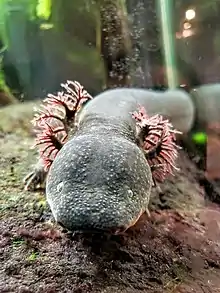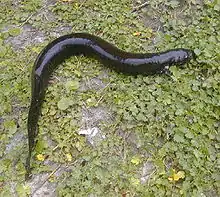Greater siren
The greater siren (Siren lacertina) is an eel-like amphibian and one of the three members of the genus Siren. The largest of the sirens and one of the largest amphibians in North America, the greater siren resides in the coastal plains of the southeastern United States.
| Greater siren Temporal range: [1] | |
|---|---|
 | |
 | |
| Scientific classification | |
| Domain: | Eukaryota |
| Kingdom: | Animalia |
| Phylum: | Chordata |
| Class: | Amphibia |
| Order: | Urodela |
| Family: | Sirenidae |
| Genus: | Siren |
| Species: | S. lacertina |
| Binomial name | |
| Siren lacertina Linnaeus, 1766 | |
Description
The greater siren is the third longest salamander in the Western Hemisphere.[4] S. lacertina is paedomorphic, as are all sirens. They lack hindlimbs as well as a pelvic girdle, and have external gills all throughout their lives along with small lungs. They lack eyelids, and have an unfused pectoral girdle.[5] Greater sirens measure around 1.5 cm (0.59 in) in length upon hatching and then grow to lengths ranging from 18 to 97 cm (7 to 38 in).[6][7][8] Weight can range from 55 to 1,000 g (1.9 to 35.3 oz).[9][10] Coloration varies throughout their range, but they are generally an olive or gray color with small yellow or green dots on their sides. They have about 36 to 40 costal grooves between their armpits and their cloaca.[11] Younger sirens also have a light stripe along their sides, which fades with age. The front legs, each with four toes, are so small that they can be hidden in the gills.
In terms of sensory organs, greater sirens rely on both a modified Jacobson's organ and a lateral line system over their small eyes. It is possible that they are capable of sensing disturbances in electrical fields.[12]
.jpg.webp) Greater siren skull & hyoid
Greater siren skull & hyoid.jpg.webp) Greater siren skeleton
Greater siren skeleton
Diet

Greater sirens are carnivorous and prey upon invertebrates (such as insects, crustaceans, gastropods, bivalves, spiders, molluscs, and crayfish)[13] and aquatic vertebrates (such as small fish)[13] with a possible preference for molluscs,[11] although they have been observed to eat vegetation such as algae.[14][13] In addition, materials that are non-animal were found in their digestive tract added to amounts of 75% or greater. [15]
Ecology and behavior
Greater sirens play a crucial role in aquatic food webs and have been described as midlevel predators.[16] Sirens swallow molluscs whole and will pass the shell as waste.[17] They are nocturnal and spend the day in dense vegetation.[12] Their lifespan in the wild is unknown, but in captivity they can live up to 25 years. Greater sirens can vocalize, producing clicks or yelps sounding similar to the call of the American green tree frog.[11] They are able to aestivate for multiple years if necessary, burrowing into mud and exuding a cocoon of dead skin cells. This has been seen during times of drought and hydroperiod fluctuations.[18] The record can be up to 3 years.[19] Known predators include the American alligator and the mud snake.[12] Other predators of this species are poorly documented. However, on June 19,2008 a greater siren was consumed by a two-toed amphiuma, indicating that this species could be an additional predator of the greater siren.[20]
Breeding
Their spermatozoa possess a pair of flagella, and their courtship behavior is unknown.[5] Mating occurs in February and March. After the eggs have been laid, the father will continuously fan its tail back and forth over or through the nest. The father will aggressively guard the nest from potential threats, including other sirens, and even the mother of the clutch. After 2 months, the eggs hatch, and the fathers depart from the nest.[21] Youth live in shallower water than adults, often among the roots of water hyacinths.[12]
Distribution and habitat
Greater sirens inhabit the coastal plain from Washington, D.C., to Florida and Alabama.[22] A population of sirens in the Rio Grande around Texas and Tamaulipas in Mexico was tentatively determined to be S. lacertina; however, recent studies have refuted this claim. Greater sirens live in wetlands, preferring those with a slow or nonexistent current and a thick layer of organic material. They are capable of inhabiting seasonal and permanent wetlands given their ability to aestivate,[11] and will burrow into mud if their wetland dries up.[22] They are predominately found in the deep benthic zone where aquatic insects are most abundant.[23] Associated habitat for greater sirens includes vegetative ditches, and various other forms of slow, or stagnant bodies of water. Often during the day, they seek refuges from predators and are found under logs and various other structures.[24]
Interaction with humans
Trapping techniques
S. lacertina is difficult to capture because of their preference for areas with thick vegetation. Standard methods such as dip-netting, seining, and dredges are ineffective in such habitats. The use of aquatic funnel traps, commercially produced to capture crayfish, has been found effective for use on Siren and Amphiuma species and there is no risk of drowning the animals. Each trap consists of the trap body, three funnels, and a neck with a lid at the top.[25]
Conservation
Greater sirens are classified as Least Concern by the International Union for Conservation of Nature, although they have been extirpated from some of their former range due to habitat loss. They are protected under Mexican law and are assigned to the "Special Protection" category.[22]
References
- Fossilworks
- Parra-Olea, G.; Wake, D.; Hammerson, G.A. (2008). "Siren lacertina". IUCN Red List of Threatened Species. 2008: e.T59492A11937094. doi:10.2305/IUCN.UK.2008.RLTS.T59492A11937094.en. Retrieved 12 November 2021.
- https://explorer.natureserve.org/Taxon/ELEMENT_GLOBAL.2.106536/Siren_lacertina
- Luhring, Thomas Marshall. Population ecology of greater siren, Siren lacertina. OCLC 1256711146.
- Vitt, Laurie J.; Caldwell, Janalee P. (2014). Herpetology (Fourth ed.). London: Elsevier. ISBN 978-0-12-386919-7.
- Heisler, N.; Forcht, G.; Ultsch, G.R.; Anderson, J.F. (1982). "Acid-base regulation in response to environmental hypercapnia in two aquatic salamanders, Siren lacertina and Amphiuma means". Respiration Physiology. 49 (2): 141–58. doi:10.1016/0034-5687(82)90070-6. PMID 6815749.
- Greater Siren – North Carolina. Herpsofnc.org (2007-09-22). Retrieved on 2013-01-03.
- Siren intermedia. AmphibiaWeb (2003-12-04). Retrieved on 2013-01-03.
- Martin, Karen M.; Hutchison, Victor H. (1979). "Ventilatory Activity in Amphiuma tridactylum and Siren lacertina (Amphibia, Caudata)". Journal of Herpetology. 13 (4): 427–434. doi:10.2307/1563477. JSTOR 156347.
- Deyle, Anna C. (2011) Population Genetics of Amphiuma means and Siren lacertina in Central Florida. M.S. Thesis, University of South Florida
- . "Greater Siren (Siren lacertina) Savannah River Ecology Laboratory. University of Georgia.
- McKenzie, Kimberley. "Siren lacertina". Animal Diversity Web. University of Michigan Museum of Zoology. Retrieved 25 March 2018.
- "Siren lacertina". Animal Diversity Web.
- Hill, Robert L.; Mendelson III, Joseph R.; Stabile, Jennifer L. (2015). "Direct Observation and Review of Herbivory in Sirenidae (Amphibia: Caudata)". Notes of the Southeastern Naturalist. 14 (1): N5–N9. doi:10.1656/058.014.0104. S2CID 86233204.
- Hanlin, Hugh G. (1978). "Food Habits of the Greater Siren, Siren lacertina, in an Alabama Coastal Plain Pond". Copeia. 1978 (2): 358–360. doi:10.2307/1443585. ISSN 0045-8511. JSTOR 1443585.
- Luhring, Thomas. "POPULATION ECOLOGY OF GREATER SIREN, SIREN LACERTINA". esploro.libs.uga.edu. Retrieved 2023-04-25.
- Burch, Paul Randolph; Wood, John Thornton (1955). "The Salamander Siren lacertina Feeding on Clams and Snails". Copeia. 1955 (3): 255–256. doi:10.2307/1440485. ISSN 0045-8511. JSTOR 1440485.
- Snodgrass, Joel; Ackerman, Joel; Bryan, Albert; Burger, Joanna (1999). "Influence of hydroperiod, isolation, and heterospecifics on the distribution of aquatic salamanders (Siren and Amphiuma) among depression wetlands". Copeia. 1999 (1): 107–113. doi:10.2307/1447391. JSTOR 1447391.
- Etheridge, Kay (1990). "The Energetics of Estivating Sirenid Salamanders (Siren lacertina and pseudobranchus striatus)". Herpetologica. 46 (4): 407–414. ISSN 0018-0831. JSTOR 3892939.
- Schalk, Christopher M.; Crawford, Brian A.; Luhring, Thomas M. (2009). "A Note on Predation of the Greater Siren (Siren lacertina)". Bulletin of Chicago Herptologica. 44 (4).
- Tomaschke, Phillip (2023). "The Greater Siren: An Overview of Captive Care and Breeding". Responsible Herpetoculture Journal. 1 (7): 9–15.
- IUCN. "Siren lacertina". IUCN Red List of Threatened Species. Retrieved 25 March 2018.
- Luhring; Crawford, B.; Schalk, C. (2010). "Summer micrhabitat use of the Greater Siren (Siren lacertina) and Two-toed amphiuma (Amlphiuma means) in an isolated wetland". Amphibia Reptilia. 2010 (2): 251-256. doi:10.1163/156853810791069155.
- Martof, Bernard S. (1973). "Siren lacertina Linnaeus Greater Siren". Catalogue of American Amphibians and Reptiles.
- Johnson, Steve A.; Barichivich, William J. (2004-06-01). "A Simple Technique for Trapping Siren Iacertina, Amphiuma means, and Other Aquatic Vertebrates". Journal of Freshwater Ecology. 19 (2): 263–269. doi:10.1080/02705060.2004.9664540. ISSN 0270-5060. S2CID 22870356.

